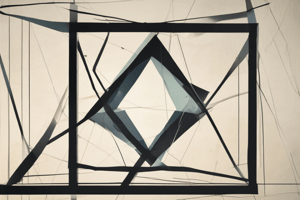Podcast
Questions and Answers
In a quadrilateral, how are diagonals defined?
In a quadrilateral, how are diagonals defined?
- As any line segment joining consecutive midpoints
- As any line segment connecting consecutive vertices
- As any line segment joining nonconsecutive vertices (correct)
- As any line segment connecting opposite midpoints
How many distinct diagonals can a quadrilateral have?
How many distinct diagonals can a quadrilateral have?
- Three (correct)
- Two
- Four
- One
What is true about the diagonals in a parallelogram?
What is true about the diagonals in a parallelogram?
- Each diagonal bisects the other diagonal (correct)
- They do not intersect
- They intersect at 90-degree angles
- They are always equal in length
Which shape has diagonals that also pass through each other's midpoint(s)?
Which shape has diagonals that also pass through each other's midpoint(s)?
What is a characteristic of rhombus diagonals?
What is a characteristic of rhombus diagonals?
How do rectangular diagonals relate to the adjacent sides of a rectangle?
How do rectangular diagonals relate to the adjacent sides of a rectangle?
What type of intersection do the diagonals of a square create?
What type of intersection do the diagonals of a square create?
What does it mean if a quadrilateral contains only reflex interior angles?
What does it mean if a quadrilateral contains only reflex interior angles?
In a quadrilateral, when are the product of the diagonal lengths greater than the sum of the squared lengths of the sides?
In a quadrilateral, when are the product of the diagonal lengths greater than the sum of the squared lengths of the sides?
Which condition makes the inequality hold true: $4 \times 6 < 8^2 + 12^2$?
Which condition makes the inequality hold true: $4 \times 6 < 8^2 + 12^2$?
What role do diagonals play in determining in a quadrilateral's properties?
What role do diagonals play in determining in a quadrilateral's properties?
Why are diagonals important in various applications like artworks and architecture?
Why are diagonals important in various applications like artworks and architecture?
Study Notes
Diagonals of Quadrilaterals
Quadrilaterals are four-sided, two-dimensional shapes with unique properties when it comes to their internal lines called diagonals. In this exploration, we'll delve into the concept of diagonal lines within quadrilateral figures and examine how they impact shape characteristics.
A diagonal is defined as any line segment joining nonconsecutive vertices of the quadrilateral. A quadrilateral can have up to three distinct diagonals, depending upon its specific configuration. Let's consider some common situations involving these intriguing lines.
Case Study I: Parallelograms
In parallelograms, there exists one pair of parallel sides. Each diagonal intersects both pairs of opposite sides at their midpoints. As a result, each diagonal bisects the other diagonal, meaning that the ratio of lengths between either point along a diagonal and the closest endpoint will remain constant.
Case Study II: Rectangles
Rectangles are special cases of parallelograms where all angles measure (90^\circ), and the adjacent sides are congruent. Therefore, rectangular diagonals also pass through each other’s midpoint(s).
Case Study III: Rhombi
Rhombuses share similarities with squares, except they do not possess equal angles. However, like squares, rhombuses exhibit center symmetry, implying that their diagonals meet at right angles. This characteristic holds true regardless of whether rhombus diagonals are drawn from vertex to vertex or edge to edge.
Case Study IV: Squares
As mentioned earlier, squares belong to the family of rhombuses due to their unique qualities such as having equal side lengths and angle measures ((90^\circ)). Interestingly, square diagonals create a (90^\circ) intersection, implying that one diagonal bisects the orthogonal diagonal into halves.
Now let's explore certain relationships among diagonals and quadrilateral measurements:
- If a quadrilateral has unequal sides, then the product of the length of two diagonals is less than the sum of the squared lengths of the quadrilateral's four sides.
- For instance, if (\overline{AB}) = 4 cm, (\overline{CD}) = 6 cm, (\overline{AE}) = 8 cm, (\overline{BD}) = 12 cm, the inequality reads: [ 4 \times 6 < (8)^2 + (12)^2 ] which simplifies to (24 < 224).
- Some quadrilaterals may contain reflex angles—those exceeding (180^\circ). When a quadrilateral contains only reflex interior angles, its diagonals must intersect.
Diagonals play vital roles in determining geometric properties and proximity estimations in various applications, including artworks, architecture, computer animation, and the design of technical equipment. Understanding them helps us comprehend more complex shapes better, inspiring curiosity and discovery throughout our journey in geometry.
Studying That Suits You
Use AI to generate personalized quizzes and flashcards to suit your learning preferences.
Description
Dive into the world of quadrilaterals and their diagonal lines. Learn about the unique properties of diagonals in different types of quadrilaterals, including parallelograms, rectangles, rhombi, and squares. Discover how diagonals intersect and divide quadrilaterals, impacting their shapes and characteristics.




